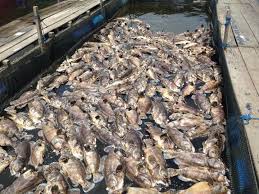Comparative Molecular Characterization of three Diplozoon species from Fishes of Kashmir Valley
Keywords:
Diplozoon; Ribosomal DNA; Schizothorax; Kashmir; Phylogenetic treesAbstract
Present study reports the results of molecular analysis of the internal transcribed spacer (ITS) of ribosomal DNA of 3 Monogenean species using polymerase chain reaction (PCR), nucleotide sequencing and construction of phylogenetic trees from different fish hosts of Kashmir. The present study shows that the size of the amplified product is 873 bp long for D. kashmirensis; 1120 bp long in D. aegyptensis and 687 bp long in D. guptai revealing that there are intraspecific differences in their base pair lengths. Guanine and Cytocine (G+C) content of three Diplozoon species was found nearly constant for three species i.e., 47% (D. kashmirensis); 47% (D. aegyptensis) and 48% (D. guptai), this GC richness contributes to physical attributes of RNA structures, as there is correlation between GC content and optimal growth temperature. An important observation during the present study has been noticed that Schizothorax niger is infected by all the three species of Diplozoidae: D. kashmirensis; D. aegyptensis and D. guptai, but when all six fishes were collected simultaneously, parasitism by all the parasite species was never observed. Phylogenetic trees Maximum Parsimony (MP), Maximum Likelihood (ML) and Neighbor Joining (NJ) showed that D. kashmirensis and D. aegyptensis share a common host Carassius carassius and S. niger.
References
Bakshi, S.A. (1999). Fish parasites of some lakes of Kashmir with an analysis of seasonality of incidence and their maturation with regard to different ecological factors. Doctoral Thesis, University of Kashmir, India.
Blair D, Barker SC (1993). Affinities of the Gyliauchenidae: Utility of the 18S rRNA gene for phylogenetic inference in the digenea (Platyhelminthes). International journal for Parasitology 23:527-532.
Cable J, Harris PD, Tinsley RC, Lazarus CM (1999). Phylogenetic analysis of Gryrodactylus spp. (Platyhelminthes: Monogenea) using ribosomal DNA sequences. Canadian Journal of Zoology, 77:1439-1449.
Cunningham CO (1997). Species Variation within the Internal Transcribed Spacer (ITS) Region of Gyrodactylus (Monogenea: Gyrodactylidae) Ribosomal RNA Genes. The Journal of Parasitology 83(2):215-219.
Cunningham CO, McGillivray DM, Mackenzie K (1995). Phylogenetic analysis of Gyrodactylus salaries Malmberg, 1957 based on the small subunit (18S) ribosomal RNA gene. Molecular and Biochemical Parasitology 71:139-142.
Desdevises Y, Jovelin R, Jousson O, Morand S (2000). Comparision of ribosomal DNA sequences of Lamellodiscus spp. (Monogenea, Diplectanidae) parasiting Pagellus (Sparidae, Telostei) in the North Mediterranean Sea: species divergence and coevolutionary interactions. International Journal for Parasitology 30:741-746.
Fayaz A, Chishti MZ (1999). Fish Trematode Parasites of Kashmir. Part-I. Genus Diplozoon Nordmann, 1832 (Monogenea, Polyophisthocotylea) Orient Sci 4(2):79-91.
Gao Q, Chen MX, Yao WJ, Gao Y, Song Y, Wang GT, Wang MX, Nie P, (2007). Phylogeny of diplozoids in five genera of the subfamily Diplozoinae Palombi, 1949 as inferred from ITS-2 rDNA sequences. Parasitology 134:695–703.
Huyse T, Volckaert FAM (2002). Identification of host-associated species complex using molecular and morphometric analyses, with the description of Gyrodactylus rugiensoides n. sp. (Gyrodactylidae, Monogenea). Int J Parasitol 32:907–919.
Jiang NCH, Wu BH, Wang SX (1985). Four new species of parasitic Diplozoon from freshwater fishes of the subfamily Gobioninae. Acta Zootaxonomica Sinica 10:239-245.
Khotenovsky IA (1985). Fauna of the USSR. Monogenea. Nauka, Leningrad.
Kritscher E (1991). Diplozoon bileki nov. spec. (Plathelhminthes: Monogenea: Diplozoidae), ein neues Doppeltier von den Kiemen von Barbus plebejus euboicus Stephanidis, 1950 (Pisces: Cyprinidae), gesammelt auf der Insel Euba (Grienchenland). Annalen des Naturhistorischen Museum in Wien, Serie B Botanik und Zoologie 92:251-255.
Lambert A, Le Brun N (1988). Hypothese sur l’origine biogeographique de Diplozoon (Monogenea, Polyopisthocotylea). Ann Parasit Hum Comp 63:99-102.
Matejusova I, Koubkova B, D’Amelio S, Cunningham CO (2001b). Genetic characterization of six species of diplozoids (Monogenea; Diplozoidae). Parasitology, 123:465–474.
Matejusova I, Gelnar M, McBeath AJA, Collins CM, Cunningham CO (2001a). Molecular markers for gyrodactylids (Gyrodactylidae: Monogenea) from five fish families (Teleostei). Int J Parasitol 31:738–745.
Matejusova I, Koubkova B, Cunningham CO (2004). Identification of European diplozoids (Monogenea, Diplozoinae) by restriction digestion of ribosomal RNA internal transcribed spacer. J Parasitol 90:817–822.
Matejusova I, Koubkova B, Gelnar M, Cunningham CO (2002). Paradiplozoon homoion Bychowsky & Nagibina, 1959 versus P. gracile Reichenbach-Klinke, 1961 (Monogenea): two species or phenotypic plasticity? Syst Parasitol 53:39–47.
Sambrook J, Russell DW (2001). Molecular cloning: a laboratory manual. Cold Spring Harbor Laboratory Press, Cold Spring Harbor, New York.
Sicard M, Desmarais E, Lambert A (2001). Molecular characterisation of Diplozoidae populations on five Cyprinidae species: consequences for host specificity. C.R. Acad Sci Paris, Sciences de la vie / Life Sciences 324:709–717.
Sicard M, Desmarais E, Vigneux F, Shimazu T, Lambert A (2003). Molecular phylogeny of the Diplozoidae (Monogenea, Polyopisthocotylea) parasitizing 12 species of Cyprinadea (Teleostei): new data about speciation. In: Combes C, Jourdane J. (eds) Taxonomy, ecology and evolution of metazoan parasites. Universitaires de Perpignan, Perpignan, pp 199–211.
Simkova A, Matejusova I, Cuningham CO (2006). Molecular phylogeny of the Dactylogyridae sensu Kritsky & Boeger (1989) (Monogenea) using the D1-D3 domains of large ribosomal subunit rDNA. Parasitology 133:43–53.
Yildirim YB, Zeren A, Genc E, Erol C, Konas E (2010). Parasitological investigation on commercially important fish and crustacean species collected from the TIGEM (Dortyol Turkey) ponds. J Anim Vet Adv 9:1597-1602.
Zhu X, Gasser RB, Chilton NB (1998). Differences in the 5.8S rDNA sequences among ascarid nematodes. International Journal for Parasitology 28:617-622.
Zietara MS, Huyse T, Lumme J, Volckaert FAM (2002). Deep divergence among subgenera of Gyrodactylus inferred from rDNA ITS region. Parasitology 124:39-52.

Published
How to Cite
Issue
Section
Copyright (c) 2015 Fayaz Ahmad, Khalid M. Fazili, Tanveer A. Sofi, Ajaz A. Waza, Rabia Rashid

This work is licensed under a Creative Commons Attribution-NonCommercial-NoDerivatives 4.0 International License.



